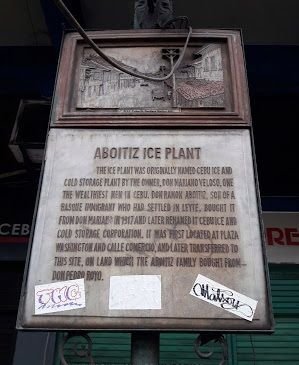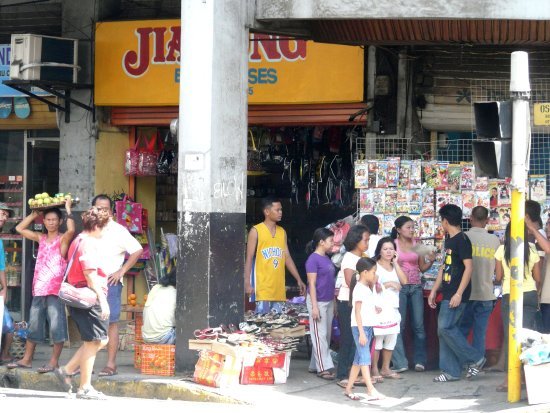
From its dirty curbs, polluted air and over crowded sidewalk, one can simply judge Colon Street for its face value alone. It's an environmentalist and a claustrophobic's worst nightmare! Also known to be teeming with snatchers and scammers, this road seems to be a nuisance to the beauty of the Queen City of the South. With IT Park, Business Park, SRP and other places in Cebu, one might deduce that this narrow road is at the bottom of the list. Yet despite its reputation, this now notorious road was once and still is the road to Cebu’s Heart.

Colon Street, believed to be the very first street in the Philippines, is deeply rooted to the rich history and development of the queen city of the south. Based on early records, this street was created by the Spaniards during the time of Miguel Lopez de Legazpi also known as El Adelantado who step foot in Cebu 1565. The street was built as a part of the first Spanish settlement in Cebu, the Villa de San Miguel or St. Michael’s Town and was named after Italian explorer Christopher Columbus (Cristobal Colon), who sailed under the grace of the king and queen of Spain.
The Forgotten History

After its establishment, Colon Street became the center of activities in downtown Cebu. It connects to the old Chinese district of Parian, where wealthy Chinese-Filipino merchants used to reside and do business in the 1950’s. The name Parian reportedly comes from “paripari,” which means “to sell or barter”. Being at the center, this strip of land has witnessed a lot of notable social and cultural events through the years and because of this, the National Historical Institute made Colon Street a Historical Landmark in 1999.
Just like anything else in this world, memories fade in time which is why markers were placed on the roadside of Colon Street containing information about what stood there decades ago to raise awareness of its huge significance and impact in the development of a city. Though some of the original markers placed there are now marred, there are still a few that has endured the test of time
Guidetti’s Studio

Dante Guidetti was an expatriate Italian artist who, upon his discharge from the Italian Army in the early years of the 20th century, found himself in Cebu. He established his studio on Colon St., where he made a name for himself as practitioner of classical sculptor and a mentor of the young artist of Cebu. He carved the figures from Greek mythology which adorned the façade of Vision Theater and which created quite a furor among the pious sectors of the populace in the 1930s.
Other works of Guidetti, some of which he executed with the assistance of his gifted pupils, were the statue of boy scout in front of the Headquarters of the BSP Lapu-lapu Council at the Corner of Osmeña Boulevard and P. del Rosario St., the Osmeña Mausoleum in San Miguel, and the statues in the Talisay Town Plaza.
Key informants: Mr. Jovito Abellana, a former pupil of Guidetti; Prof. Julian Jumalon, artist; Prof. Carmelo Tamayo, artist.
Vaño's Residence

The Vaño’s were descended from Portuguese gentleman, Don Juan Reyes, whose daughter Mariquita married Don Jaime Vaño, a Spanish mestizo from the Ilocos. The Vaño descendants married into such affluent mestizo families as Corominas, Garces, Vaño, Escaño, and Sanson.
Lu Do Copra Plant

It was once the original site of the Lu Do Copra Plant which was established in 1896. It is the biggest single unit copra crushing plant in the Far East.
Lu Do, an immigrant from Amoy, China, established a copra crushing plant on a lot on Colon Street which he had leased from Fr. Venerando Reynes in 1896. Lu Do known to the natives as Iyo Owa, started a soap and candle business which survived the revolution. He took his only son Lu Ym as his partner in 1907 and the two went into mechanized production, thus, expanding the plant, which they transferred to Plaridel St. on the site of the present Lu YM building, and later to San Nicolas, the present site. The San Nicolas Plant is now the Lu Do and Lu Ym Corporation which is considered the biggest single unit copra crushing plant in the far east.
Tamayo Residence

The niece of Don Victoriano Osmeña, Doña Januaria Osmeña Sison lived here with her husband Don Guillermo Tamayo. One of their sons grew up to be the well-known artist Camelo Tamayo, former head of the Department of Fine Arts of UP College Cebu. Professor Tamayo is noted for his rendering of the elegant Spanish churches in Cebu as well as his whimsical tartanilla paintings.
Aboitiz Ice Plant

The Ice Plant was originally named Cebu Ice and Cold Storage Plant by the owner, Don Mariano Veloso, one of the wealthiest men in Cebu. Don Ramon Aboitiz, son of a Basque immigrant who had settled in Leyte, bought it from Don Mariano in 1917 and later renamed it Cebu Ice and Cold Storage Corporation. It was first located at Plaza Washington and Calle Comercio, and later transferred to this site, on land which the Aboitiz Family bought from Don Pedro Royo.
Teatro Junquera

This was the oldest playhouse in Cebu established in 1895 by Gen. Inocencio Junquera. This was where various dramas, operas, literary-musical programs, and cinemas were held.
It was also the preferred venue for civic affairs in 1901, Gov. General William Howard Taft and the members of the Philippine Commission spoke before Cebuanos gathered at Teatro Junquera.
In 1902, Vicente Sotto staged his play, "Ang Gugma Sa Yutang Natawhan". It was the Playhouse for the coming of the silent films.
In 1920, Don Jose Avila bought the Teatro and renamed it Cine Oriente.
Note: There are still more markers that can be seen in this thoroughfare but I'll give that challenge to you to literally take a walk in time and rediscover the forgotten history.
Modern Colon
If you take a stroll in today's Colon Street, you won't spot any of Legazpi’s Colon or as it was during the 19th century, with its rows of two-storey houses facing one another on both sides of the street. The structures of antiquity boasts establishments which belonged to the ancestors of well renowned names in Cebu like Briones, Gantuangco, Lu Do, Rallos, Osmeña, Singson, Cuenco, and Martinez, among others.
Before the 90’s, when malls sprung up in other areas of the city, Colon was the center of economic activities in Cebu. Before SM and Ayala, Cebuano's flocked to commercial establishments in Colon like Plaza Fair, Gazini Plaza, Rosita’s, and Gaw Trading, Inc.

Now, Colon is truly a concrete jungle with universities here and there and some Information Technology Institutions scattered about. You can also watch movies at cheap rates in movie houses and enjoy eating at fast-food restaurants. Grocery stores, shops selling glasses, phones, appliances, and stalls displaying dresses and pirated music/movie DVDs also dominate the place. Colon is the economical choice for shopping for various items, as you can get more and pay less.

For years now, an annual event (Night market) is held in Colon Street. It is one of the main attractions of this street which brings in more people to the already crowded place. The Night market has been heavily participated mostly by the common people of Cebu especially during the Holidays. Colon is the perfect location to shop. It’s a one-stop shopping street where you can buy almost everything you desire. It’s a place where wants and needs collide. From sparkling jewelry ,RTW's, sneakers, and accessories among others.

With the modernization of Colon and being a crossroad for most routes here in Cebu, it is expected that it will almost always be jam-packed with people. Having mentioned that , with the surplus of people roaming about, the street has developed a bad reputation through the years as a lair for pickpockets and snatchers. So please do bear in mind, if you do decide to check out this historic street in Cebu, go with a group and don’t wear jewelry or bring valuables with you.
To sum it up, change is really the only thing in this world that is permanent. Colon has indeed survived for generations yet it still is one of the main places in Cebu that gives life to one of the most progressive cities in the Philippines. What used to be there generations ago may have changed for better or worst but we must always strive to remember our roots and learn from it to continue moving forward. So i challenge you to zip up, get your map and take a stroll through time and re-envision the tides of change because what we perceive as our now would not have been for what once was.
Sources:
https://www.google.com.ph/amp/s/annpeace.wordpress.com/2009/03/14/colon-street-heritage-markers/amp/
http://www.thevisualtraveler.net/2017/04/colon-streets-forgotten-heritage-markers.html
http://www.phtourguide.com/colon-street-oldest-street-in-the-philippines/
https://en.wikipedia.org/wiki/Miguel_L%C3%B3pez_de_Legazpi
https://www.tripadvisor.com.ph/Attraction_Review-g298460-d2086858-Reviews-Colon_Street-Cebu_City_Cebu_Island_Visayas.html
Image Sources:
1, 2, 3, 4, 5, 6, 7, 8, 9, 10, 11,


.gif)

Thanks for this, the reading was worth the time. Really learnt a lot.
nice way to introduce about Cebu Colon road and culture of Philippine Keep sharing your work. pics are amazing. have a nice time @themanualbot
Thanks for the historical information sharing. Learnt a lot through your post
..best buy is in colon @themanualbot
I agree! haha samot nas colon night market. :)
Ha ha...😃😃
i just followed you cause your posts seems to be informative you are
doing great ,,If you are interested in cryptocurrency visit my steemit
for more information @reewy ,, and thank you again for your great
posts
Yes i am also follwed every post of the @themanualbot...really very informative and nice posts sharing...you will also know most of info throug his blog ...enjoi the posts..
Nightmarket in colon is <3 love though its crowded hehehe
the place where i spent half of my life. :)
Very nice informative post...the photos looking awesome...thank you for sharing with us....@themanualbot